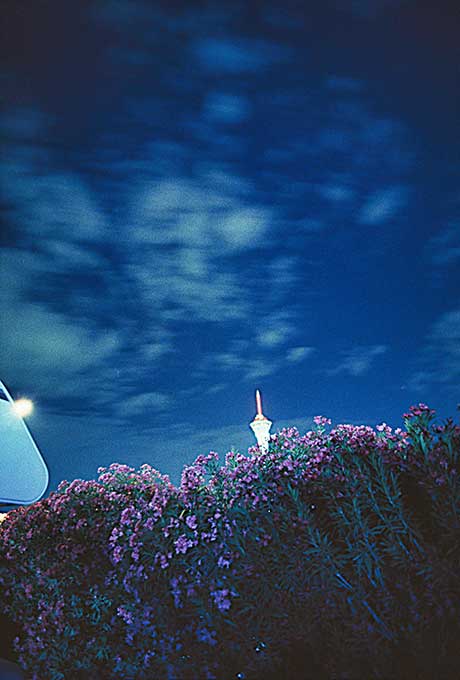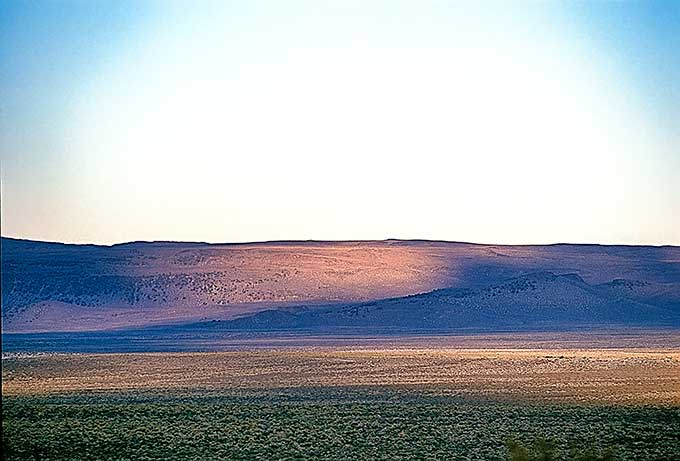You are in „Things and Concepts“
All things are independent yet interrelated parts of a whole, which is life. Everything is connected. – What a thought! But this idea of wholeness, of the fundamental unity underlying everything, is in stark contrast to the conception of the world that traditionally prevails in our minds. It is the conception of the so-called classical physics of Isaac Newton, which we also call mechanistic worldview. The fundamental concept of this theoretical framework is the existence of solid, material bodies that move independently of each other in an empty space. After all, this corresponds to our everyday experience. We step against a big stone and bounce back. This would not be possible if the stone was not solid in itself and separate from us. Then there is the idea of fixedness: if we know the variables of a system, we can calculate its state at any time in the future or past. Because everything is determined in its course by the known laws of nature.

However, there have always been schools of thought that have challenged these fundamental connections. For instance, George Berkeley, in his 1710 „Treatise on the Principles of Human Knowledge,“ expressed his belief that the material world around us is merely a product, or quasi-illusion, of our perceptual apparatus. Even older and more well-founded are the thought structures of the eastern philosophies.
The goal of the philosophical teachings of Asia is an immediate experience of reality, and this, the experience of absolute reality, is called mysticism. Inherent in all these teachings is the principle of the inseparability of man and the cosmos. We are not isolated parts, but integrated into an all-encompassing totality. The spirit and the universe are mutually interpenetrated, but we must overcome obstacles to experience this connection.

Hinduism originated in India and has its spiritual roots in the Vedas, ancient scriptures that were probably recorded between 1500 and 500 BC. According to Hindu teachings, there exists an original wholeness that creates everything and into which everything passes. This unity is called Brahman. It is the essence of all things but cannot be comprehended with our intellectual faculties and consequently cannot be put into words. According to Hindu mythology, Brahman sacrifices itself and thereby becomes the world, which in turn acquires divine status. This act of creation is called Lila – the play of God – and the world is its place of performance. As long as man is under the impression of this constantly recurring, rhythmic divine creation – Lila – he cannot recognize the reality of things. We call this state of confusion between the manifold forms of the divine play and reality Maya. But the meaning of Maya is not that the things of the world are illusions themselves. The illusion lies in us and our way of thinking as long as we consider the world and its objects to be real instead of recognizing them as products of our mind alone. There is still one aspect missing, the Karma. This is the dynamic, all-things life-giving power of the creation, Lila. As long as we are blinded by Lila, we are bound by Karma. The real essence of Hinduism is to liberate ourselves from it, to realize the inner unity of creation, including ourselves, and to understand that everything originates from the same source. To accomplish this step, the teachings offer many different ways, rituals and spiritual exercises adapted to the different levels of consciousness of people. Yoga, for example, is one of them.
„Words cannot describe the joy of the soul whose impurities have been washed away in the depths of contemplation, which is one with the Atman, one’s Self. Only those who have experienced this joy know what it is. … As water becomes one with water, and fire with fire, and air with air, so the mind becomes one with the unlimited mind and thus experiences freedom.“
Maitri Upanishad

Buddhism dominated the spiritual ideas of all of Asia for many hundreds of years beginning in the 6th century BC. The king’s son, Siddhartha Gautama, also known as the historical Buddha, founded it. In contrast to Hinduism and Taoism, Buddhism is not concerned with the experience of wholeness as an end in itself but with the personal situation of people and the reasons for their suffering. It is therefore a psychotherapeutic teaching and not a metaphysical one.
After seven years of asceticism, Siddhartha reached enlightenment through deep meditation, which Buddhists call the unsurpassed, complete awakening. This experience surpasses all intellectual boundaries and renders the world accessible as Acintya, where everything manifests as a non-differentiated entity. From this, Siddhartha, who thus became the Buddha (the Awakened One), developed his teaching, which presents itself in the four noble truths.
The first noble truth describes man’s initial state as Dukha, or frustration. This is his inability to recognize the basic condition of life: Everything around us is in perpetual transition. Nothing is permanent, and what appears to be so is only an illusion, known as Maya. This is the root of Buddhism.
The second noble truth pertains to the root cause of all suffering, Trishna, which is the act of clinging. This means clinging to the illusory forms of Maya, whereby we resist the natural flow of things. Every action we take leads to another, trapping us in Samsara, the cycle of birth and death propelled by Karma, the never-ending chain of cause and effect.
The third noble truth is the hope for the cessation of all suffering. It says that it is possible to break out of Samsara, free ourselves from Karma and reach Nirvana. That state of consciousness beyond all concepts in which the oneness of all life can be experienced. To reach Nirvana is to awaken and attain Buddhahood.
Finally, the fourth noble truth is the teaching that leads to the cessation of all suffering, the eightfold path of self-development. It describes righteous seeing, righteous knowledge, righteous actions, righteous consciousness, and righteous meditation.
„All conditionally originated phenomena are flowing-transient. If one looks at this with the eye of wisdom, weariness of suffering arises. Here lies the path to freedom. Ultimately, all conditionally arising phenomena are non-sustainable or intangible. When this is seen with the eye of wisdom, weariness of suffering arises. Here lies the path to freedom. The non-self is all conditional and unconditional things. When this is seen with the eye of wisdom, weariness of suffering arises. Here lies the path to freedom. When the constant arising and passing away of all things physical and spiritual is seen, true joy arises. Here lies the realm of the deathless.“
Quote from the awakened Buddha

Taoism is based on the writings of two Chinese philosophers, Laotse and Chuang-tzu, who are said to have lived in 600 and 400 BC, respectively. These are the Tao Te Ching and the Chuang-tzu. If Confucianism was the philosophy of social order, then Taoism can be said to be the authentic metaphysical teaching or religion of China.
Just like Hinduism and Buddhism, Taoism assumes the existence of an ultimate reality that unifies and explains all things we perceive. It is called the Tao, which originally meant „way“ and meant the way of the universe. Interpreted in this sense, the Tao is the counterpart of Hindu Brahman and Buddhist Nirvana. However, unlike them, the Tao possesses a dynamic all its own – a cyclical alternation of expansion and contraction from which things constantly become and pass away. This perpetual change is the essence of the universe, and its study through nature is the essence of Taoism. It enables man to recognize the unchanging elements in eternal change and align his life with them to achieve harmony. The two poles of the cyclic transformations are Yin and Yang. Their dynamic interplay produces the manifestations of the Tao that we perceive.
The well-known Yin-Yang symbol beautifully illustrates this inherent dynamic of everything. While it shows a symmetrical arrangement of the light Yang and the dark Yin, this is not static in nature. Rather, it is a rotational symmetry that suggests the continuous cycle described. The two points of reversed color in the planes express the idea that each of the two forces already carries its opposite when it reaches its extreme value.

„This“ is also That. That“ is also this. … The very essence of Tao is that „This“ and „That“ cease to be opposites. This essence, acting as an axis, serves as the center of the circle and responds to the endless transformations.
Taoist Wisdom
The fundamental connections cannot be understood rationally because the mind as a mere part of the whole cannot understand itself. Only the feeling, but not the direct perception or the rational understanding brings us further. Access grants only the sensual experience.
„Clouds, torsos, shells, peppers, trees, rocks, smokestacks are but interdependent, interrelated parts of a whole, which is life.
Life rhythms felt in no matter what become symbols of the whole.
The creative force within man recognizes and records these rhythms.
The medium most suitable to him, to the object, to the moment, feeling the cause, the life within the outer form.
Recording unfelt facts by acquired rule results in sterile inventory.
To see the thing itself is essential: the Quintessence revealed directly without the fog of impressionism – the casual noting of a superficial phase, or transitory mood.
This then: to photograph a rock, have it look like a rock, but be more than a rock. – Significant presentation – not interpretation.“
Edward Weston, The Daybooks of Edward Weston Vol. 2 (5)

Previous The great emptiness
(1) Hans-Peter Dürr, Geist, Kosmos und Physik, Crotona Verlag 2010, S. 15
(2) Fritjof Capra, Das Tao der Physik, Fischer Verlag 2010, S. 68
(3) Heinz R. Pagels, The Cosmic Code, Simon And Schuster 1982, S. 270Ff
(4) Hans-Peter Dürr, Geist, Kosmos und Physik, Crotona Verlag 2010, S. 33
(5) The Daybooks of Edward Weston, Vol. 2, Aperture Books 1973, S. 154
If you found this post useful and want to support the continuation of my writing without intrusive advertising, please consider supporting. Your assistance goes towards helping make the content on this website even better. If you’d like to make a one-time ‘tip’ and buy me a coffee, I have a Ko-Fi page. Your support means a lot. Thank you!


 Since I started my first website in the year 2000, I’ve written and published ten books in the German language about photographing the amazing natural wonders of the American West, the details of our visual perception and its photography-related counterparts, and tried to shed some light on the immaterial concepts of quantum and chaos. Now all this material becomes freely accessible on this dedicated English website. I hope many of you find answers and inspiration there. My books are on
Since I started my first website in the year 2000, I’ve written and published ten books in the German language about photographing the amazing natural wonders of the American West, the details of our visual perception and its photography-related counterparts, and tried to shed some light on the immaterial concepts of quantum and chaos. Now all this material becomes freely accessible on this dedicated English website. I hope many of you find answers and inspiration there. My books are on